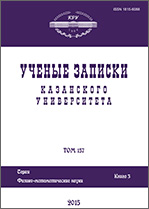|
|
Kazanskii Gosudarstvennyi Universitet. Uchenye Zapiski. Seriya Fiziko-Matematichaskie Nauki, 2009, Volume 151, Book 1, Pages 82–89
(Mi uzku722)
|
 |
|
 |
This article is cited in 1 scientific paper (total in 1 paper)
The XII International Youth Scientific School "The Coherent Optics and Optical Spectroscopy"
Nanomodified Bacteria: Detection of Individual Cells Using Surface-Enhanced Raman Scattering
A. I. Zamaleevaa, M. Kahramanb, M. Culhac, R. F. Fakhrullina
a Chair of Biochemistry of Kazan State University
b Istanbul Technical University, Turkey
c Yeditepe University, Istanbul, Turkey
Abstract:
The layer-by-layer method of coating bacterial cells with polyelectrolytes and silver nanoparticles for improving the surface-enhanced Raman scattering (SERS) spectra is reported. First, the bacteria cell wall is coated with poly(allylamine) hydrochloride (PAH) and/or poly(styrene) sulfonate (PSS) and then with citrate reduced silver nanoparticles. In order to increase the stability of the coating, other layers of PAH/PSS are formed on the surface. The SEM and AFM images indicate isolated nanoparticles and aggregates of nanoparticles on the bacterial wall. The coating of bacterial cells with silver nanoparticles not only serves for their preparation for SERS measurement but also helps to visualize the coated bacterial cells under the ordinary whitelight microscope objective due to efficient light scattering properties of silver nanoparticles. The two bacteria that differ in shape and cell wall biochemical structure, Escherichia coli and Staphylococcus cohnii, Gram-negative and Gram-positive respectively, are used as models. Reproducible SERS spectra were obtained from single and aggregated silver nanoparticle-coated cells. These spectra can provide valuable information about chemical structure of bacterial cell wall. Preliminary results reveal that the approach could be used for single bacterial cell identification. Key words: layer-by-layer, polyelectrolyte nanofilms, silver nanoparticles, single cell, surface-enhanced Raman scattering.
Keywords:
layer-by-layer method, polyelectrolyte nanofilms, silver nanoparticles, single cell, surface-enhanced Raman scattering.
Received: 21.01.2009
Citation:
A. I. Zamaleeva, M. Kahraman, M. Culha, R. F. Fakhrullin, “Nanomodified Bacteria: Detection of Individual Cells Using Surface-Enhanced Raman Scattering”, Kazan. Gos. Univ. Uchen. Zap. Ser. Fiz.-Mat. Nauki, 151, no. 1, Kazan University, Kazan, 2009, 82–89
Linking options:
https://www.mathnet.ru/eng/uzku722 https://www.mathnet.ru/eng/uzku/v151/i1/p82
|

| Statistics & downloads: |
| Abstract page: | 714 | | Full-text PDF : | 196 | | References: | 46 |
|




 Contact us:
Contact us: Terms of Use
Terms of Use
 Registration to the website
Registration to the website Logotypes
Logotypes








 Citation in format
Citation in format 
